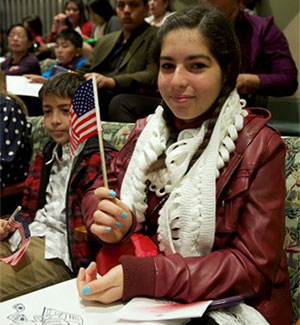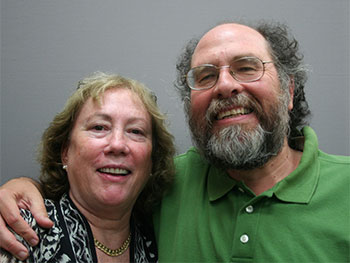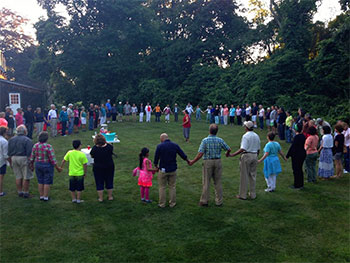Blog Posts | October 29, 2020
Share ThisOctober 29, 2020
For the past 25 years, the Institute of Museum and Library Services has awarded the National Medal for Museum and Library Service. This prestigious achievement is awarded to libraries and museums that make significant and exceptional contributions to their communities.
In honor of a quarter-century of Medals, IMLS looked back on the hundreds of libraries and museums that have been awarded this honor. These were just a few of the many winners honored for their exceptional work in changing the lives of children, families, and communities across the U.S.
Do you know an exceptional museum or library? Nominations for the FY 2021 Medals are open through Monday, November 2.

In 2015, Los Angeles Public Library was awarded a National Medal for its efforts in providing immigrant communities gateways to citizenship, financial and health resources, literacy learning and education, and career opportunities in science and technology. The Los Angeles Public Library’s “Path of Citizenship” program led more than 13,500 people into the naturalization process, while providing services that address the larger issue of immigrant integration. The library created Citizenship Corners in all 73 of its locations with resources in multiple languages and library staff trained in the naturalization process. With resources from the U.S. Citizenship and Immigration Services/IMLS partnership, the library established a model for other cities. Los Angeles is building on the success of the program and has joined with New York and Chicago to launch “Cities for Citizenship,” a major nationwide initiative to increase the rate of naturalization. The Los Angeles Public Library now addresses other issues of immigrant integration, with new and expanded programs on literacy, financial, and consumer health and education.
The Children's Museum of Indianapolis
The Children’s Museum of Indianapolis was awarded the National Medal in 2014, but their innovation and creativity hasn’t slowed down. In 2018, the museum welcomed a record-breaking 1.27 million visitors thanks to the opening of their Riley Children’s Health Sports Legends Experience. Additionally, the museum boasts five floors of premier exhibits, a planetarium, and a professional children’s theater, making it the world’s largest children’s museum. Children and family members of all ages are immersed in the sciences, arts, humanities, and history through hands-on learning experiences and performances.
Erica Hahn, an avid visitor, explained how the museum not only provided an excellent learning experience for her son, but also a nurturing environment for his growth. Her doctors had said that her son, Spencer, had suffered a stroke in utero that destroyed the left side of his brain and would never walk or talk. However, Spencer reached developmental milestones, like speaking his first words and taking his first steps, at the museum. The museum is at the forefront of creating learning experiences with the power to transform the lives of children and families. Spencer continues to visit the museum to learn about other cultures, history, science, and to visit his favorite green dinosaur, Rex.

In 2009, Braille Institute Library Services was awarded a National Medal for its commitment to providing high-quality programming and library services to its blind, visually impaired, reading disabled, and physically handicapped patrons in southern California, many of whom are over the age of 65. Outreach efforts included several book-of-the-month clubs, a children’s book club, and an annual summer reading program that promotes childhood literacy by encouraging children to continue reading even when school is not in session. The library also served as a one-stop shop for audio, Braille, and digital books for the blind and visually impaired. Since its beginning, Braille Institute Library Services has been and remains committed to empowering patrons with knowledge, literacy, and independence.
Listen to two community members share their story of the first time they visited the Braille Institute of America.
The Western Folklife Center is one of relatively few museums focused on rural life. In 2004, the center was awarded a National Medal for its world-class programming and exhibits, most notably its annual National Cowboy Poetry Gathering. The center totted a robust national, regional, and local impact with its 23-year history of fieldwork, unique archival collections, annual Gathering event, collaborations with the Library of Congress's American Folklife Center and other national partners, and educational programs reaching approximately 5,000 Elko County schoolchildren annually, including cowboy poetry presentations in the schools, hands-on activities at the center, and tours of exhibits.

Tomaquag Museum is Rhode Island's only Native American museum serving as a bridge between the Native community's needs, history, culture, and impact on today's society. In 2016, it was recognized for its goal is to empower Indigenous people, engage the mainstream community, and educate people through its many programs, partnerships, films, books, tours, exhibits, lectures, workshops, and classes. Through its multi-faceted public programs, Tomaquag Museum strives to educate the public and promote thoughtful dialogue regarding Indigenous history, culture, and arts. Through the “Indigenous Lifeways” podcast, the museum explores these stories and amplifies the Indigenous voice. Podcasts reached more than 9,000 downloads in one year, demonstrating the museum’s achievements in encouraging Indigenous people to document their stories.
In 2013, Waukegan Public Library was recognized for its fresh, effective approaches to promoting literacy across the community. Waukegan has a Hispanic population that is three times higher than the state average, with 55 percent of residents speaking a language other than English. One of the library’s first initiatives was to create a culturally sensitive conversational ESL program that places the learner at the center to ensure his or her success in daily life. In one year, 255 students participated in the conversational ESL program, with most moving on to a GED program. Another initiative, Promotoras Ambassador Program, empowered an outreach worker to be responsible for raising awareness about library resources in the Hispanic community and understanding the needs of Spanish speakers. Both programs are still going strong today.
Oregon Museum of Science and Industry
In 2007, this part brain-powered playground for kids and adults, part cutting-edge classroom for communities across the state, was awarded a National Medal for its efforts to inspire wonder in every visitor. The Oregon Museum of Science and Industry (OMSI) is one of the largest and most successful campuses of its kind in the U.S. OMSI reached more than 200,000 students in six western states, including Alaska, through traveling programs and fairs, which included interactive presentations on forensics, live animal demonstrations, and the popular Discovery Dome Portable Planetarium.
OMSI also partnered with NASA to launch Science, Technology, and Rural Students (STARS) to deliver hands-on training to 250–300 teachers and librarians in more than 70 schools and 13 libraries, giving them special tools to engage students, direct access to science experts, and access to digital labs and live video to extend learning. To serve inner-city young people, OMSI created a Boys and Girls Science Club for low-income youth in north and northeast Portland. The program supplied students with a safe, stable, and supportive environment, while providing an on-site science educator, equipment, hands-on activities, and monthly field trips to the museum and other science-related sites.
When Artrain USA chugs into town, communities are changed. In 2006, this traveling museum was awarded the National Medal for its effort to educate people about art and expose them to the ways it can enrich lives. Housed in vintage train cars and pulled by locomotives, Artrain USA visits several small towns of fewer than 10,000 people each year that may have little or no access to art museums. Prior to an Artrain USA visit, the museum provides a variety of tools and assistance to the host organization to ensure that the exhibition will be a community-wide success. With each new national tour, Artrain USA leaves in its tracks special art encounters for underserved individuals and new know-how for small-town arts organizations to continue thinking big.
Weippe Public Library & Discovery Center
In Idaho's remote, mountainous region, the Weippe Public Library & Discovery Center is a valued community resource and was recognized as such in 2011. The library brought high-speed internet service to the tiny town of Weippe and nearby communities, expanded the library-centered cell phone service to serve the entire community, helped residents apply for jobs and unemployment assistance, taught basic computer skills, and worked to form partnerships that would bring tourism-related jobs to the area in an effort to end persistent unemployment. It also created LEGOs-sponsored problem-solving challenges that reflect real-world situations for local youth, and provided preschool children with First Books, a program that provides free books and offers storytelling services.
Memphis Public Library and Information Center
The Memphis Public Library and Information Center in Tennessee has its own community-based radio and television stations, 19 locations, and 114 years of experience. In 2007, it was awarded a National Medal for its extensive community outreach and innovative programs. In 2006, the library recorded more than 3 million visitors and sponsored nearly 3,000 programs, averaging 26 participants per course. The library hosted PAWS for Reading, a program that gave kids the opportunity to read aloud to specially trained dogs and improve their reading skills. It also started the Read to Erase Your Fines project, which allows kids who have lost their library privileges because of overdue fines to be reinstated by reading to the elderly.
The library petitioned the State of Tennessee to become the area’s 2-1-1 information provider, giving up-to-date information and referral services pertinent to the Memphis community. It also partnered with Volunteer Income Tax Assistance and AARP to help residents prepare their filings. This success was attributed to the library’s mission to “satisfy the customer’s need to know,” and continually remain connected to the community it serves.
What’s Next
Small or large, in a historic building or on wheels, libraries and museums are touching the lives of people across the country. The IMLS National Medals have always recognized excellence, imagination, and community outreach. These institutions represent the ingenuity, and dedication of museum and library professionals to effect change in their communities, their state, and the nation—but they’re not the only ones. Nominate your local museum or library, and help tell the story of your community.
